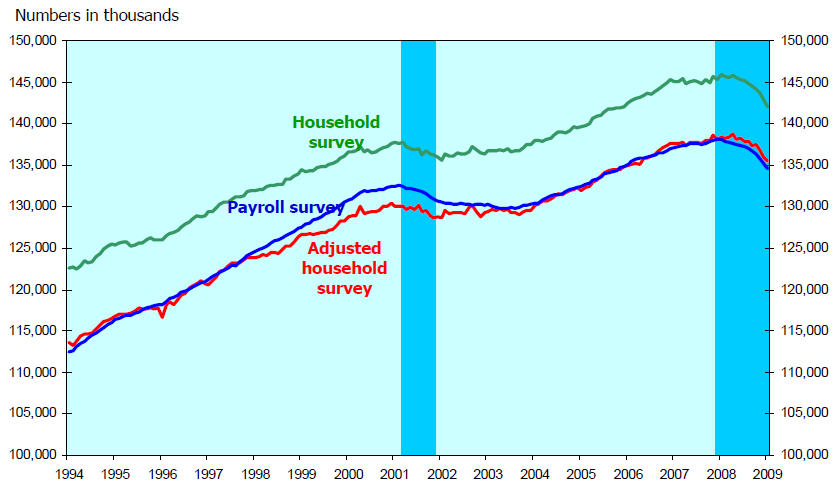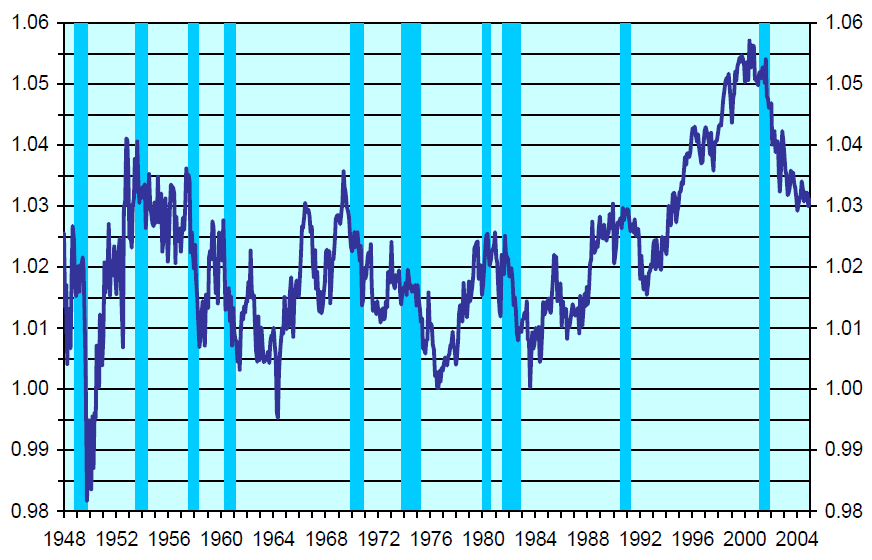Shorter version:
When the NonFarm Payroll outperforms the Household Survey, its an economic expansion; When HH survey outperforms NFP, its an economic contraction (recession)
>
Longer version:
This may be a bit wonky for some of you, but its quite fascinating:
One of my longstanding peeves has been the way some bulltards cherry pick between the Household Survey (which measures Unemployment) and the Establishment Survey (which measures non-farm payroll, occasionally called job creation). Whichever is bigger is what they choose to emphasize. The folks who abuse the data that way are economic charlatans, and should be cast out as pariahs — or at the very least, ignored. Here’s why:
These two reports measure very different things. The numbers can be off by 100s of 1,000s of jobs — and still be consistent with each other. As we have discussed all too many times, the Household survey measures:
– Agriculture and related employment;
– Uncompensated Workers;
– Unpaid Family Employees;
– Part Time Workers;
– Workers absent without pay from their jobs;
– Self employed, Work-at-home Contractors;
–none of which are counted in the Establishment (Non-Farm Payroll) Survey.
In the past, the BLS has looked at and compared the two data series. Once they made an adjustment so both surveys were counting the same thing, any gap between the two disappeared (see chart below).
However, lest we waste a good data series, the NBER looked into whether this differential had any value as an economic indicator. And according to this recent NBER paper — Exploring Differences in Employment between Household and Establishment Data — the answer is yes.
Note that the NBER is the group that determines the official beginning and ends of recessions. (The paper’s authors are from BLS, Census, and U Maryland Economic depts — they may or may not represent official NBER views).
Phillipa Dunne of the Liscio Report summed up the research thusly:
“The study demonstrates that divergences between the Current Employment Survey (aka the Establishment Survey or Nonfarm Payroll) and the Current Population Survey (aka the Household Survey) are “cyclical phenomenon,” with the CES outpacing the CPS during business-cycle expansions, and then falling back during recessions and the early stages of recoveries. The 60-year history of the ratio between the two surveys graphed below shows this clearly. (Take that, Kudlow & Co.) Also note that the ratio failed to rise during the most recent recovery, which seems to underscore the ongoing weakness in terms of employment growth.
Based on characteristics of respondents discovered in their study, the authors contend that tight labor markets create a growing number of marginal jobs that often go unreported in the Household Survey, e.g., establishments hiring short-term workers to cover busy periods, which begins to lift the Establishment Survey. As economic conditions continue to improve, workers tend to drop informal jobs (which would be reported in the CPS but not the CES) for formal jobs (that would be reported in the CES), thus widening the gap between the two surveys. These trends then reverse as economic activity falls off, with establishments laying off workers who then turn to informal employment, moving from the CES to the CPS. (see graphs below).
At first blush, that’s a reasonable interpretation of the two data series. I will see about adding this to our regular monthly charts . . .
I previously ran this graphs from BLS showing 1994-2004; Here is the updated version through 2009:
Household and Payroll Survey Employment, Seasonally Adjusted, 1994-2009
SOURCE: Bureau of Labor Statistics, February 6, 2009.
Ratio of Establishment Survey Employment to Household Survey Nonagricultural Wage and Salary Employment, 1948-2004
Source: Bowler and Morisi, 2006
>
Previously:
Redux: Household versus Establishment Surveys (July 8th, 2006)
http://www.ritholtz.com/blog/2006/07/redux-household-versus-establishment-surveys/
Household versus Establishment Surveys, part 42 (October 10th, 2006)
http://www.ritholtz.com/blog/2006/10/household-versus-establishment-surveys-part-42/
Sources:
Exploring Differences in Employment between Household and Establishment Data
Katharine G. Abraham, John C. Haltiwanger, Kristin Sandusky and James Spletzer,
NBER Working Paper No. 14805, March 2009
http://www.nber.org/papers/w14805.pdf
The Envelope Please: NBER Study finds ratio between Establishment and Household Surveys to the Cyclical
Phillipa Dunne
The Liscio Report, March 30, 2009
http://tinyurl.com/dlkn2f




What's been said:
Discussions found on the web: